1998 GMC SIERRA light
[x] Cancel search: lightPage 11 of 452
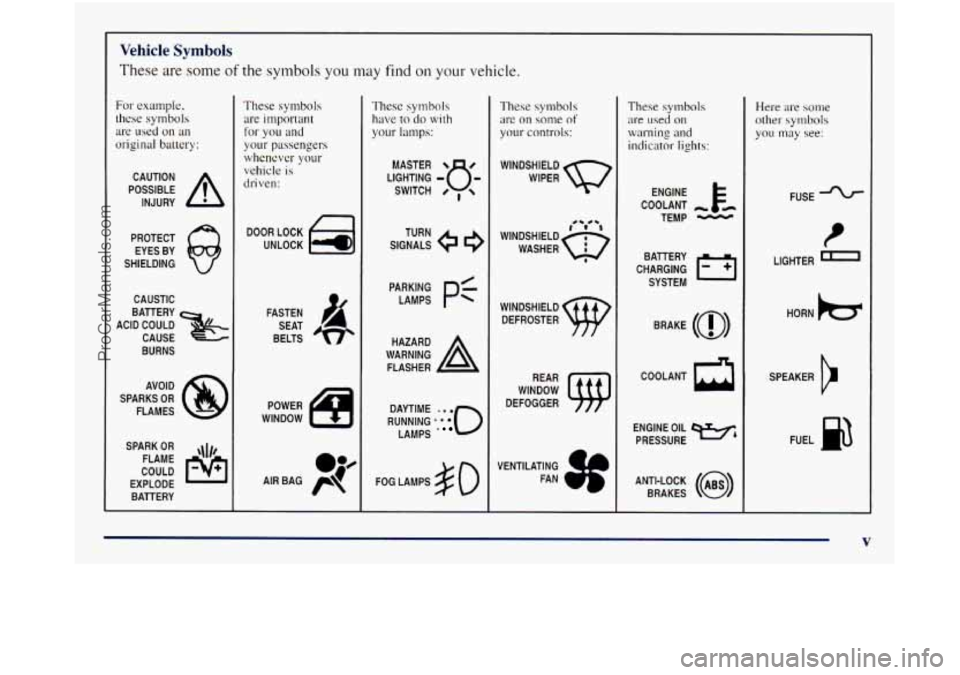
Vehicle Symbols
These are some of the symbols you may find on your vehicle.
For example.
these symbols are used
on an
originnl battery:
POSSIBLE A
CAUTION
INJURY
PROTECT EYES BY
SHIELDING
CAUSTIC
ACID COULD
BATTERY
CAUSE
BURNS
AVOID
SPARKS
OR
FLAMES
SPARK
OR ,\I/,
COULD FLAME
EXPLODE BATTERY
These symbols are important
for you
and
your passengers whenever your
vehicle is
driven:
DOOR LOCK
UNLOCK
FASTEN SEAT
BELTS
POWER
WINDOW
These symbols
have to do with
your lamps:
SIGNALS e e
TURN
RUNNING
*'***'O
DAYTIME LAMPS
*
FOG LAMPS # 0
These symbols
are on some of
your controls:
WIPER Q
WINDSHIELD
DEFROSTER
WINDOW
DEFOGGER
VENTILATING FAN
These symbols
are used on
warning and
indicator lights:
ENGINE k
COOLANT - td
TEMP -
CHARGING BATTERY
SYSTEM
BRAKE
(@)
rr
ENGINE OIL w,
PRESSURE
ANTI-LOCK
(@)
BRAKES
Here are some
other symbols
you may see:
FUSE -%-
t
LIGHTER
HORN
)tr
SPEAKER
b
FUEL no
V
ProCarManuals.com
Page 21 of 452
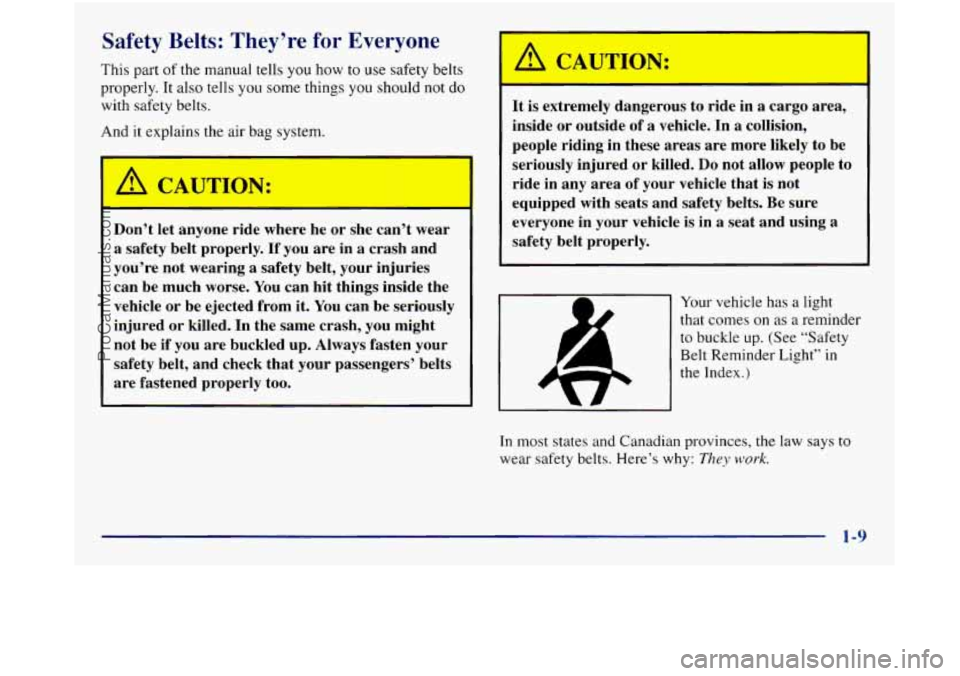
Safety Belts: They’re for Everyone
This part of the manual tells you how to use safety belts
properly. It also tells you some things
you should not do
with safety belts.
And it explains the air bag system.
’
A CAUTION:
I
- -
Don’t let anyone ride where he or she can’t wear
a safety belt properly. If you are in
a crash and
you’re not wearing
a safety belt, your injuries
can be much worse.
You can hit things inside the
vehicle or be ejected from it.
You can be seriously
injured or killed. In the same crash, you might
not be if you are buckled up. Always fasten your
safety belt, and check that your passengers’ belts
are fastened properly too. It
is extremely dangerous to ride in a cargo area,
inside or outside of a vehicle.
In a collision,
people riding in these areas are more likely to be
seriously injured or killed. Do not allow people to
ride in any area of your vehicle that is not
equipped with seats and safety belts. Be sure
everyone in your vehicle is in a seat and using a
safety belt properly.
Your vehicle has a light
that comes
on as a reminder
to buckle
up. (See “Safety
Belt Reminder Light” in
the Index,)
In most states and Canadian provinces, the law says
to
wear safety belts. Here’s why: They work.
1-9
ProCarManuals.com
Page 37 of 452
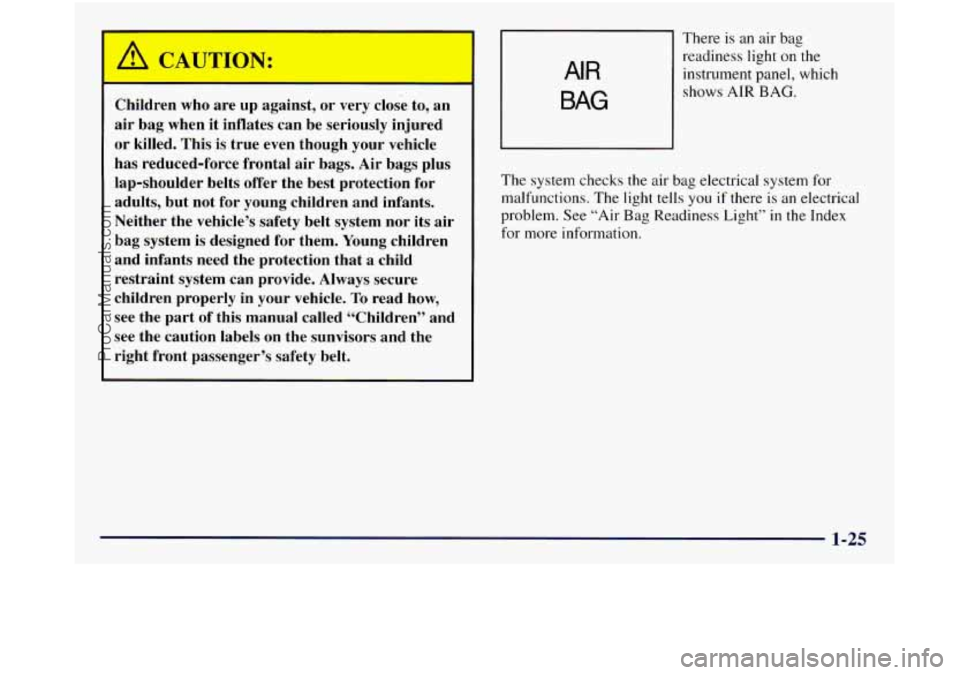
1
l Children who are up against, or very close to, an
air bag when it inflates can be seriously injured
or killed. This
is true even though your vehicle
has reduced-force frontal air bags. Air bags plus lap-shoulder belts offer the best protection for
1 adults, but not for young children and infants.
Neither the vehicle’s safety belt system nor its air
bag system is designed for them. Young children
and infants need the protection that
a child
restraint system can provide. Always secure
children properly in your vehicle.
To read how,
see the part of this manual called “Children” and
see the caution labels on the sunvisors and the
right front passenger’s safety belt.
~
AIR
BAG
There is an air bag
readiness light
on the
instrument panel,
which
shows AIR BAG.
The system checks the air bag electrical system for
malfunctions. The light tells you if there is an electrical
problem. See “Air Bag Readiness Light”
in the Index
for more information.
1-25
ProCarManuals.com
Page 75 of 452
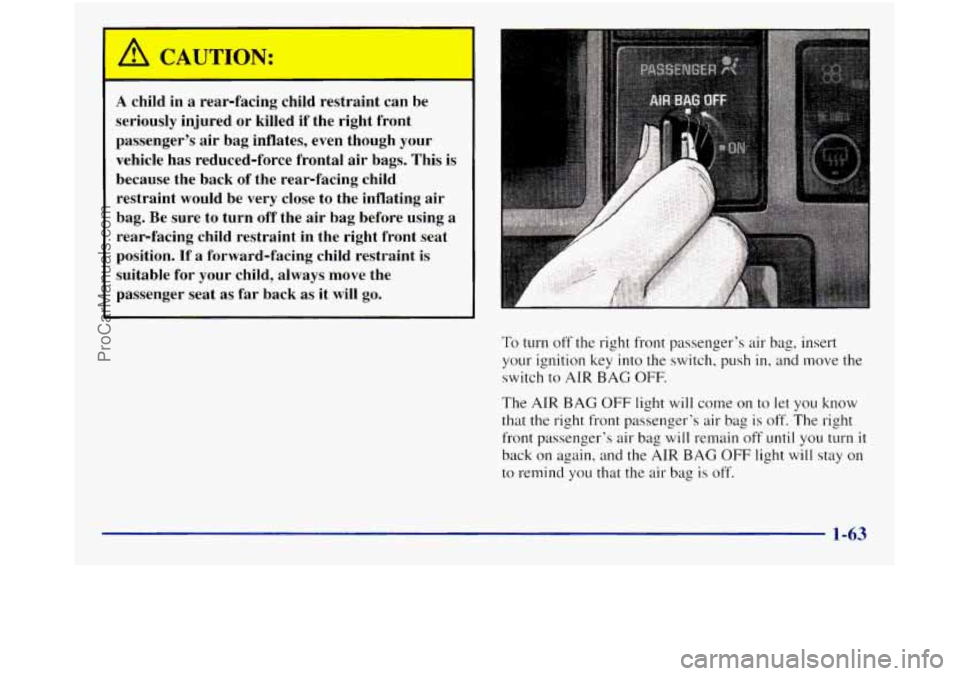
’ A CAUTION:
-
A child in a rear-facing child restraint can be
seriously injured or killed if the right front
passenger’s air bag inflates, even though your
vehicle has reduced-force frontal
air bags. This is
because the back of the rear-facing child
i restraint would be very close to the inflating air
bag. Be sure to turn off the air bag before using a
rear-facing child restraint in the right front seat
position.
If a forward-facing child restraint is
suitable for your child, always move the
passenger seat as
far back as it will go.
To turn off the right front passenger’s air bag, insert
your ignition key into the switch, push
in, and move the
switch to
AIR BAG OFF.
The AIR BAG OFF light will come on to let you know
that the right front passenger’s air bag is off. The right
front passenger’s air bag
will remain off until you turn it
back on again, and the AIR BAG OFF light will stay on
to remind you that the air bag is off.
1-63
ProCarManuals.com
Page 76 of 452

If the air bag readiness light ever comes on when
you have turned
off the air bag, it means that
something may be wrong with the air bag system.
The right front passenger’s air bag could inflate
even though the switch is off.
If this ever
happens, don’t secure a rear-facing child
restraint in your vehicle until you have your
vehicle serviced.
You’ll be using
the lap-shoulder belt. See the earlier part
about
the top strap if the child restraint has one. Be sure
to follow
the instructions that came with the child
restraint. Secure the child in the child restraint when and
as the instructions say.
1. If your vehicle has air bags and you are using a
rear-facing child restraint in this seat, make sure the
air bag
is turned off. If your child restraint is
forward-fixing, always move the seat as far back as
it will go before securing it in this seat. (See “Seats”
in the Index.)
2. Put the restraint on the seat.
3. Pick up the latch plate, and run the lap and shoulder
portions of
the vehicle’s safety belt through or
around the restraint. The. child restraint instructions
will show
you how.
If the shoulder belt goes in front of the child’s face or
neck, put
it behind the child restraint.
4. Buckle the belt. Make sure the release button is
positioned so you would be able to unbuckle the
safety belt quickly
if you ever had to.
1-64
ProCarManuals.com
Page 82 of 452
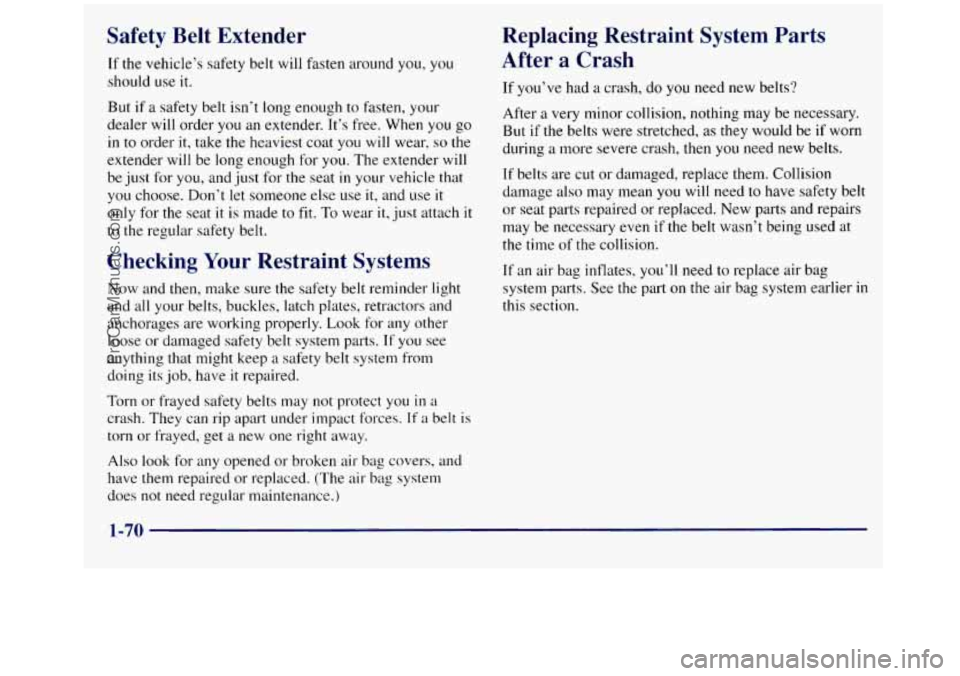
Safety Belt Extender
If the vehicle’s safety belt will fasten around you, you
should use it.
But if a safety belt isn’t long enough to fasten, your
dealer
will order you an extender. It’s free. When you go
in to order it, take the heaviest coat you will wear,
so the
extender will be long enough for you. The extender will
be just for you, and just for the seat
in your vehicle that
you choose. Don’t let someone else use it, and use
it
only for the seat it is made to fit. To wear it, just attach it
to the regular safety belt.
Checking Your Restraint Systems
Now and then, make sure the safety belt reminder light
and
all your belts, buckles, latch plates, retractors and
anchorages are working properly. Look for any other
loose or damaged safety belt system parts. If
you see
anything that might keep
a safety belt system from
doing its job, have
it repaired.
Torn or frayed safety belts may not protect you
in a
crash. They can rip apart under impact forces. If a belt is
torn or frayed, get
a new one right away.
Also look for any opened or broken air bag covers, and
have
them repaired or replaced. (The air bag system
does not need regular maintenance.)
Replacing Restraint System Parts
After a Crash
If you’ve had a crash, do you need new belts?
After
a very minor collision, nothing may be necessary.
But if the belts were stretched, as they would be if worn
during
a more severe crash, then you need new belts.
If belts are cut or damaged, replace them. Collision
damage also may mean you will need
to have safety belt
or seat parts repaired or replaced. New parts and repairs
may be necessary even
if the belt wasn’t being used at
the time
of the collision.
If an air bag inflates, you’ll need to replace air bag
system parts. See the part
on the air bag system earlier in
this section.
1-70
ProCarManuals.com
Page 85 of 452

Section 2 Features and Controls
Here you can learn about the many standard and optional features on your vehicle, and information on starting,
shifting and braking. Also explained are the instrument panel and
the warning systems that tell you if everything is
working properly
-- and what to do if you have a problem.
2-2
2-
3
2-4 2-5
2-6
2-9
2-
10
2- 10
2-1 1
2-12
2- 14
2-15
2-18
2-2
I
2-25
2-26
2-29 Keys
Tailgate
Third Door
(If Equipped)
Door Locks
Keyless Entry System (If Equipped)
Theft
PasslockTM
New Vehicle ”Break-In”
Ignition Positions
Starting Your Gasoline Engine
Engine Coolant Heater (If Equipped) Automatic Transmission Operation
Manual Transmission Operation Four-wheel Drive
(If Equipped)
Parking Brake
Shifting Into Park
(P) (Automatic
Transmission Models
Only)
Shifting Out of Park (P)
(Automatic Transmission) 2-29
2-30
2-30
2-3 1
2-32
2-32
2-34
2-35
2-4
1
2-43
2-45
2-5
1
2-60
2-62
2-64 Parking
Your Vehicle (Manual Transmission
Models
Only)
Parking Over Things That Burn
Engine Exhaust
Running Your Engine While You’re Parked
(Automatic Transmission)
Locking Rear Axle (If Equipped)
Windows
Tilt Wheel (If Equipped)
Turn Signal/Multifunction Lever
Exterior Lamps
Interior Lamps Mirrors
Storage Compartments
Instrument Panel
Instrument Panel Cluster
Warning Lights, Gages and Indicators
ProCarManuals.com
Page 88 of 452
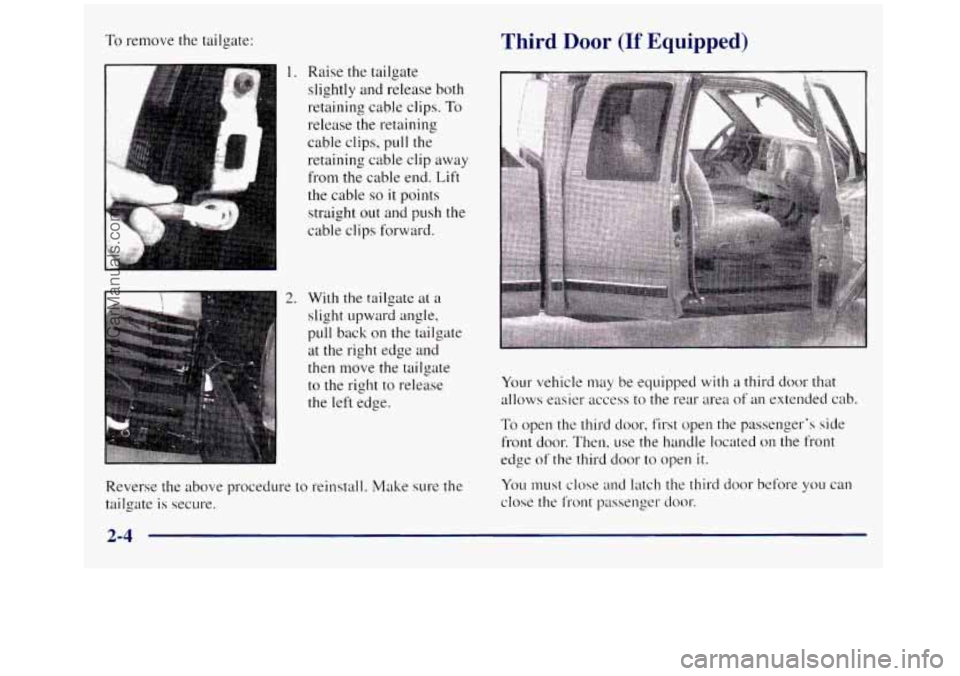
To remove the tailgate:
2.
Raise the tailgate
slightly and release both
retaining cable clips.
To
release the retaining
cable clips, pull the
retaining cable clip away
from the cable end. Lift
the cable
so it points
straight out and push the
cable clips forward.
With the tailgate at a
slight upward angle.
pull back on the tailgate
at the right edge
and
then move the tailgate
to the right
to release
the left edge.
Re.verse the above procedure
to reinsla
tailgate is secure. dl. Make sure t :he
Third Door (If Equipped)
Your vehicle may be equipped with a third door that
allows easier access
to the rear area of an extended cab.
To open the third door, first open the passenger’s side
front door. Then, use the handle located on the front
edge
of the third door to open it.
You must close and latch the third
door before you can
close the front passenger door.
2-4
ProCarManuals.com